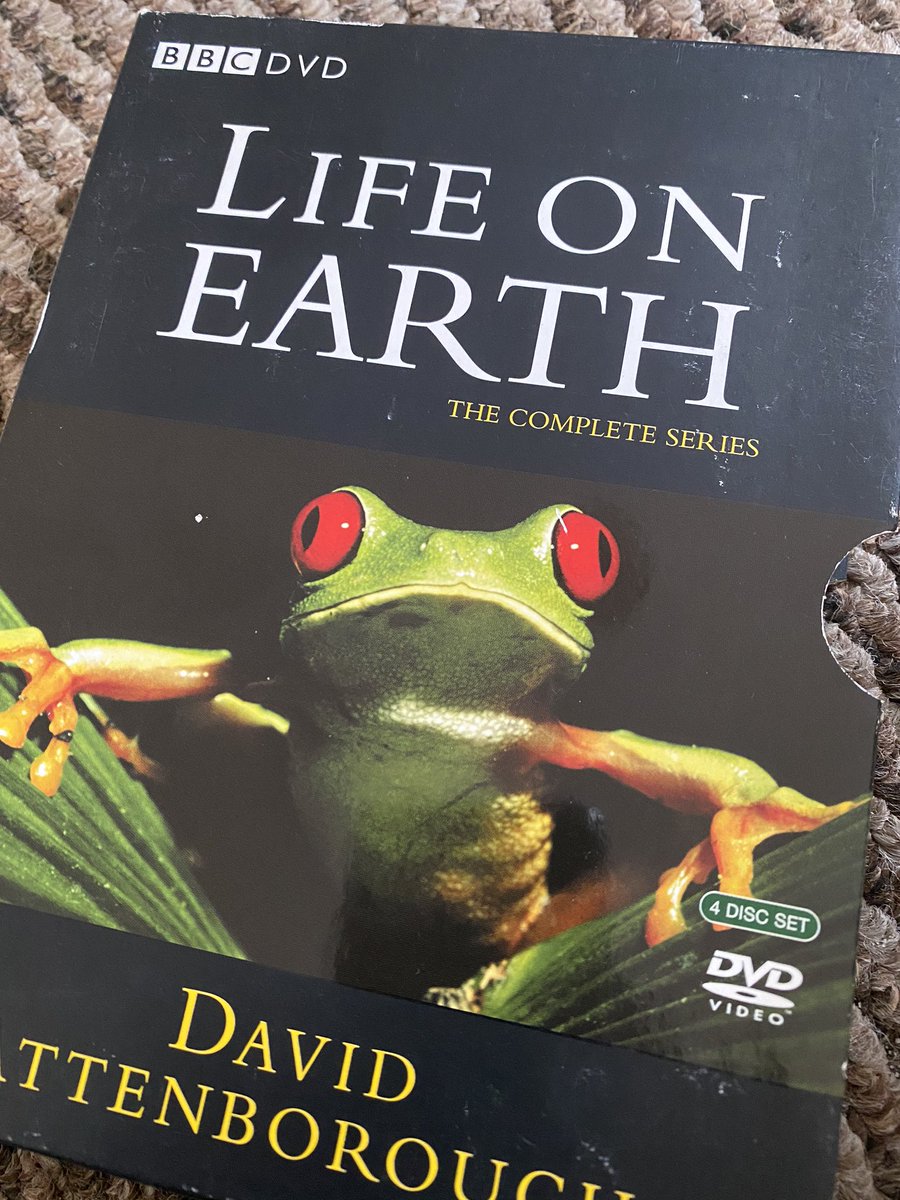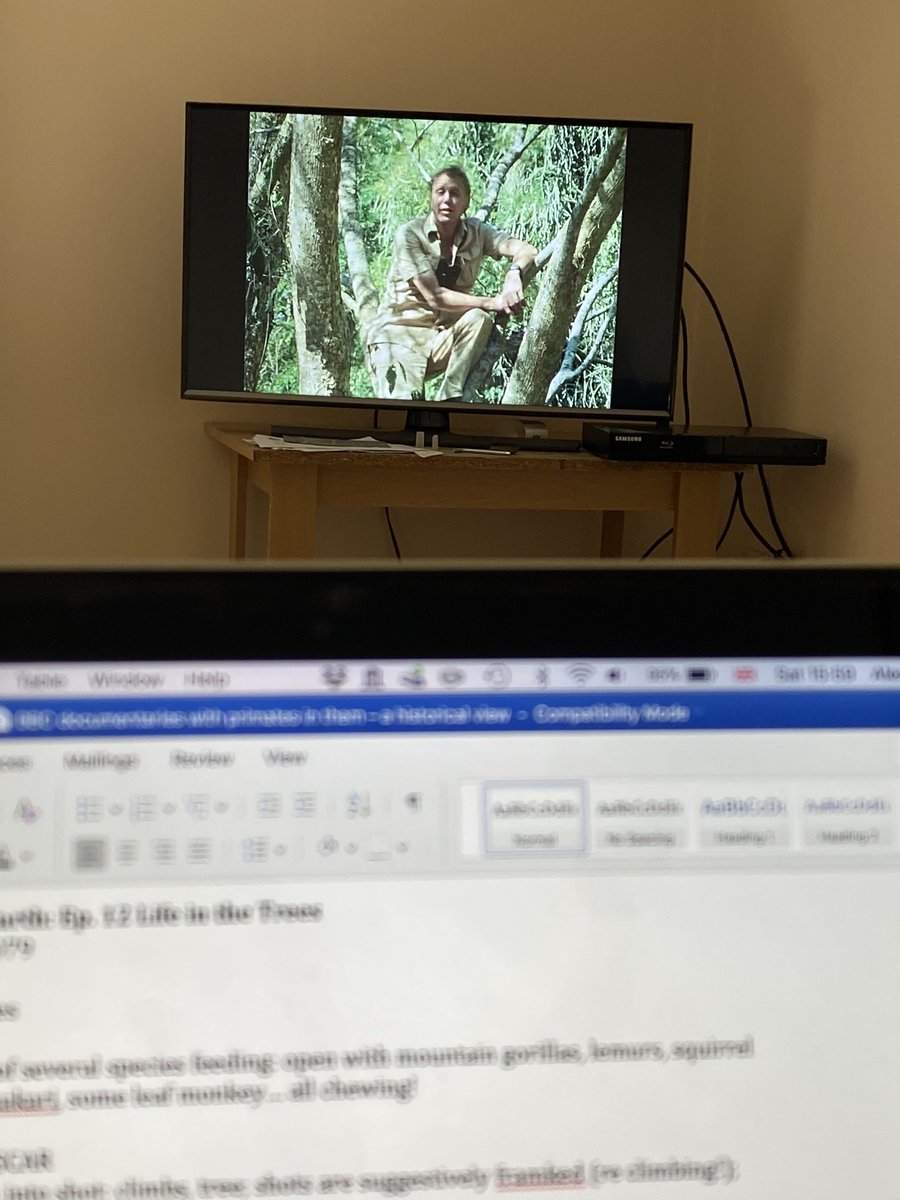Woke up early, watched an absolute classic. Ep. 12 Life in the Trees from the very first mega BBC series Life on Earth (1979!). The episode is all about #primates so check back again sometime later today or tomorrow for some thoughts & analysis! -AG #BangorDoesPrimates #pregame
So a few initial thoughts. This programme was made in the late 1970s. It was something never done before. It aired in 1979 which is ... a long time ago. Yet my first thought when I watched it today again was that it was remarkably great to watch still... #BangorDoesPrimates
Despite the less than HD film footage and the odd aspect ratio on the screen. At its heart there was a story that is as exciting today as it must have been to those viewers swing it for the first time on the BBC the year before I was born myself. #BangorDoesPrimates
That story was the story of how primates (and us) came to be and how the diversity of shapes, forms & lifestyles somehow makes perfect sense, in the light of evolution. Attenborough is a great storyteller and in 1979 he wanted to tell the story of life itself. #BangorDoesPrimates
LOE (& this episode) aims to establish the key characteristics of different life forms (primates) and explain why they are the way they are. And how life evolved in a seemingly directed fashion from single cells organisms to humans. From lemurs to apes. #BangorDoesPrimates
Evolution is not so neat or directional though. But for TV in the 1970s some simplifications had to be made (I imagine). #BangorDoesPrimates
Another thing that grabbed me when rewatching the episode was the relentless pace of it! And in a good way. Dense narration (with enough pauses), many sequences and many species. I was getting ready for something slower but it felt quite the opposite. #BangorDoesPrimates
I did get a bit miffed though when DA kept talking over some chimps pant hooting! #BangorDoesPrimates
There were sequences I didn’t quite recall and despite the old feel to the footage and some of the editing, it was still rather fresh. Just try to imagine how incredible it would have been to see this in 1979 - the first tv series of its kind at the time #BangorDoesPrimates
I also just realized how limited the gif selection is for the young DA genre. This is one (the only) of the better ones ... not a single nonhuman primate in sight #BangorDoesPrimates
Anyway. Tomorrow I will get back to this thread to actually say more stuff about the primate episode more specifically. I’ve made notes! #BangorDoesPrimates
It’s finally the weekend and I’m going to do some tweets about this classic episode from Life on Earth. Shown for the first time on 3 April 1979! #LifeInTheTrees #BangorDoesPrimates #Primates
Ep.12 has the very ambitious aim to tell us everything we need to know about the primates - this super diverse and rich order of mammals. Can Sir David do it? #LifeInTheTrees #BangorDoesPrimates #Primates
The magic of TV is to make complex, detailed stories into simple easy-to-follow, exciting, inspirational packages of sound and images and the BBC are very good at this #LifeInTheTrees #BangorDoesPrimates #Primates
We begin in Madagascar. The first 11.5 minutes of the programme and devoted to the lemurs. #LifeInTheTrees #BangorDoesPrimates #Primates
Attenborough climbing up a tree. The shots are very suggestively framed (about climbing)! He hoist himself up into a comfortable sitting position and turns to the camera... #LifeInTheTrees #BangorDoesPrimates #Primates
DA to camera: & #39;If you spend your life clambering about in trees two of the most useful things to have are a pair of hands with which to grip the branches and a pair of eyes, which face forward and both can focus on the same thing... & #39; #LifeInTheTrees #BangorDoesPrimates #Primates
& #39;...so that you can accurately judge the distance of, say, the next branch on which you want to jump or swing.& #39;
#LifeInTheTrees #BangorDoesPrimates #Primates
#LifeInTheTrees #BangorDoesPrimates #Primates
DA: & #39;There are about 200 different kind of animals in the world that have those two characteristics. We group them together and call them primates.& #39;
#LifeInTheTrees #BangorDoesPrimates #Primates
#LifeInTheTrees #BangorDoesPrimates #Primates
This is the first moment I am reminded I am watching a programme from 1979. Back then the approximation of ~200 species of primates would have been spot on. Today it& #39;s very much not. #LifeInTheTrees #BangorDoesPrimates #Primates
Today, the International Union for Conservation of Nature recognise 512 species of primates, quite an increase since that 1979 estimate! http://www.primate-sg.org/who_ares_the_primates/">https://www.primate-sg.org/who_ares_... #LifeInTheTrees #BangorDoesPrimates #Primates
Why so many primates today compared to 1979? Aren& #39;t they all in decline and going extinct? Well, some have gone extinct, but quite a few have been also described in the last decades. #LifeInTheTrees #BangorDoesPrimates #Primates
Sometimes what we thought was 1 species, later turned out to be multiple. Techniques from molecular ecology (DNA) have helped a lot with identifying new species (especially among mouse lemurs who are difficult to tell apart!) #LifeInTheTrees #BangorDoesPrimates #Primates
In other instances - entirely new species have been recorded not because of genetics research but because they lived in such remote locations that it& #39;s taken a while for researchers to come across them and describe them for science. #LifeInTheTrees #BangorDoesPrimates #Primates
So in some ways, it& #39;s seems much more exciting to be a primatologist today, than back in 1979 when Life on Earth was made... #LifeInTheTrees #BangorDoesPrimates #Primates
Anyway - back to the TV! We& #39;re still in Madagascar and Sir David is up a tree telling us about how useful it is to have hands and forward-facing eyes. Two of the defining primate features. #LifeInTheTrees #BangorDoesPrimates #Primates
Life on Earth as a whole is organised around the & #39;story& #39; of life, the evolution of all the living things here. It tries to make sense of the astonishing diversity and this episode is no different - the narrative structure is clean. #LifeInTheTrees #BangorDoesPrimates #Primates
Of course evolution as a process is rarely so clean but it& #39;s difficult to convey this nuance in 55 or so minutes. So Attenborough is trying to find a clean story that links all the primates together in a neat evolutionary progression #LifeInTheTrees #BangorDoesPrimates #Primates
From the most & #39;primitive& #39; that live in Madagascar (all the lemurs) to the most advanced that live pretty much everywhere (humans). #LifeInTheTrees #BangorDoesPrimates #Primates
DA: & #39;At first sight, this animal doesn& #39;t look much like a monkey... & #39; Yes, well, that& #39;s because it& #39;s not, David. #LifeInTheTrees #BangorDoesPrimates #Primates
But the way DA introduces and explains the ring-tail lemur in these first minutes of the programme is so simple and yet so effective. He compares their fluffy tail to a cat; their moist nose to a dog.... #LifeInTheTrees #BangorDoesPrimates #Primates
And then he blows it wide open: & #39;But its hands give away its true character – no dog or cat has a grasp like this. This creature is a true primate.& #39; #LifeInTheTrees #BangorDoesPrimates #Primates
The ring-tail lemur sequence is good: moving about, scent-marking on the saplings, foraging, males having a stink fight up a tree, mother and infant, those grasping hands useful for the baby to keep clinging! #LifeInTheTrees #BangorDoesPrimates #Primates
Lemurs are descended from shrew-like mammals, according to DA in this episode. It& #39;s not quite so simple but this Wikipedia page is remarkably detailed if you want to find out more about the evolution of lemurs: https://en.wikipedia.org/wiki/Evolution_of_lemurs">https://en.wikipedia.org/wiki/Evol... #BangorDoesPrimates #Primates
They& #39;ve diversified immensely once they became isolated on Madagascar and have adapted to all sorts of habitats. In this episode we also see some that live in the dry, spiny forests: the wonderfully acrobatic sifaka, and in moist forest: the indris. #BangorDoesPrimates #Primates

 Read on Twitter
Read on Twitter



